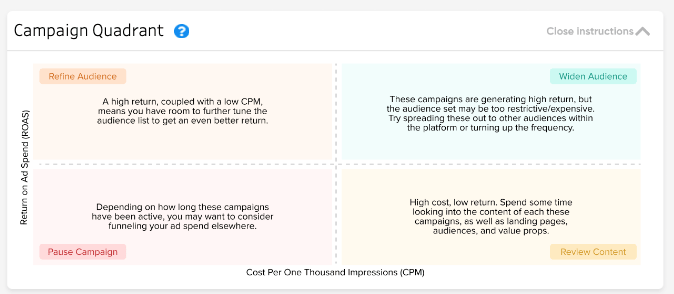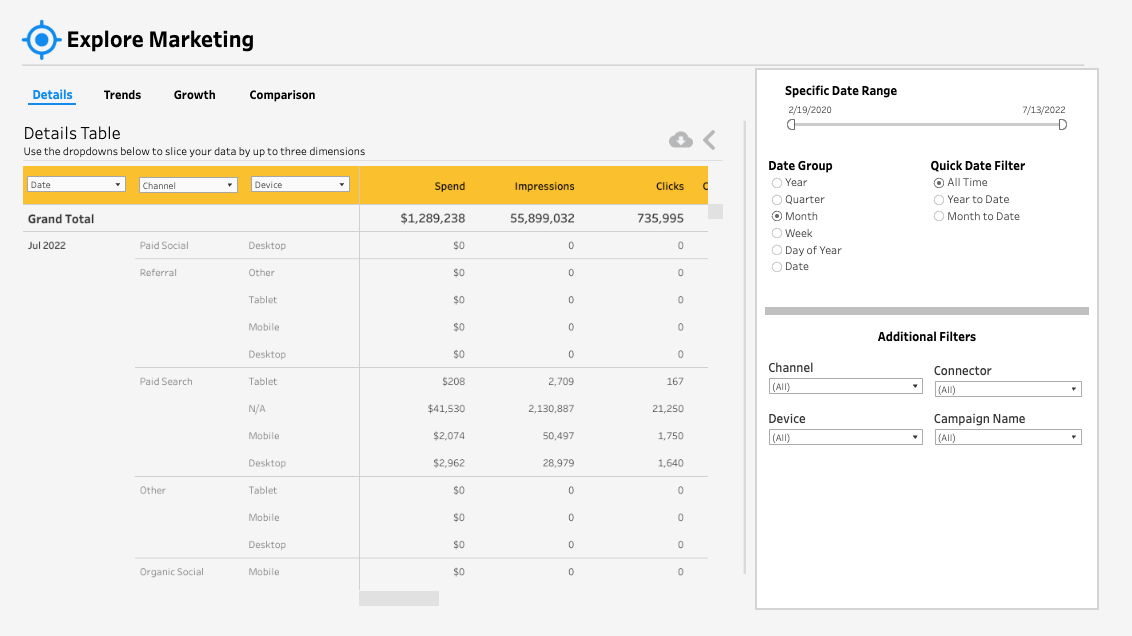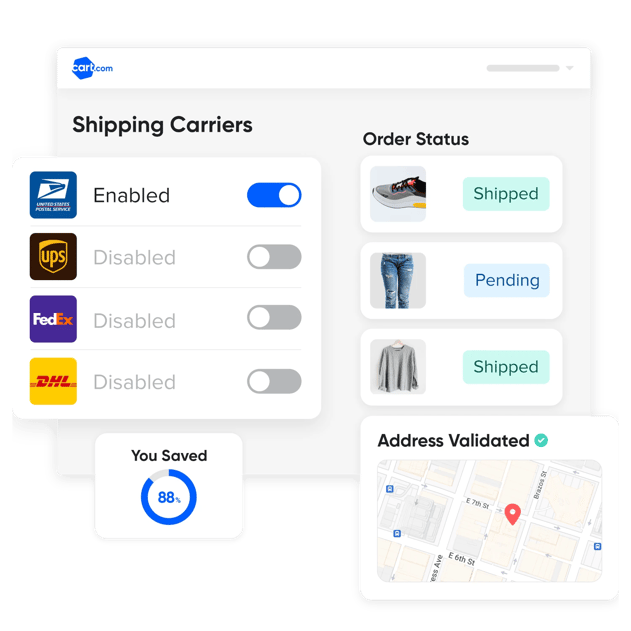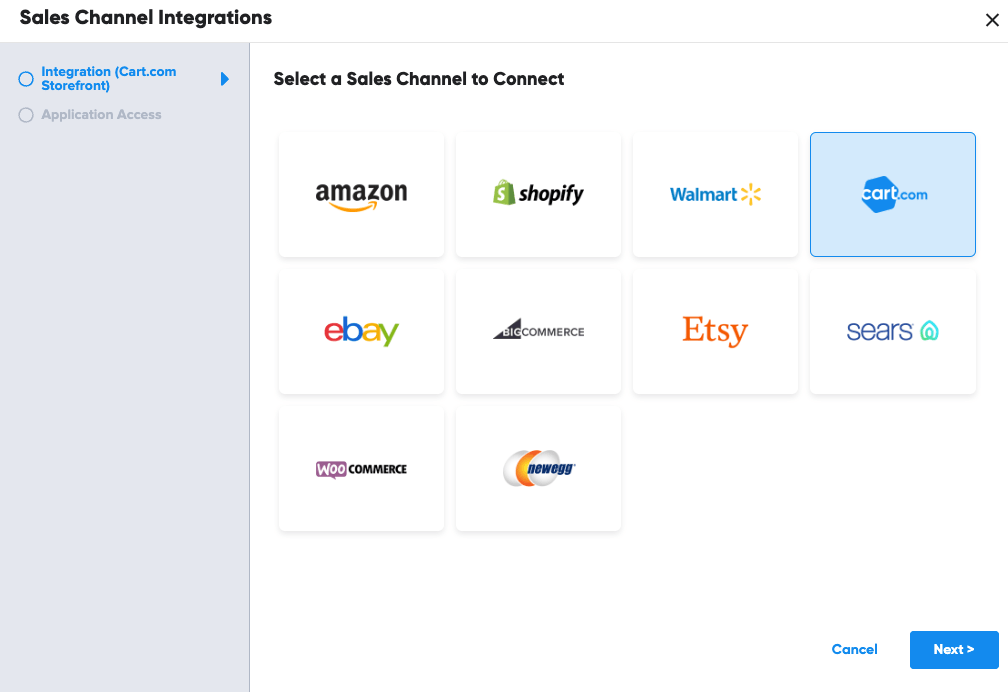Unified Analytics
Optimize paid & social ads with campaign-specific recommendations
The new Paid Search and Social Exploration pages within Unified Analytics provide analysis of how marketing campaigns are performing compared to spend and surface recommendations to help shift budget to the most effective campaigns.
The top row of the dashboard is filterable by data connector and time period to give an at-a-glance overview of how paid search or social ads have been performing.


Additionally, Unified Analytics makes it easier for customers to optimize ads by analyzing each campaign and sorting them into categories with a recommended set of actions.
Optimizing paid search spend
Campaign Readout on the Paid Search Dashboard shows all active campaigns for the selected time period and connectors along with their key performance indicators and adjustment recommendations. The Campaign Quadrant plots each campaign by ROAS and CPC. Customers can hover over each campaign for more information about their performance.

- Increase Bids (high ROAS, low CPC) - These campaigns are low-cost and perform well. Customers can likely generate even better returns by increasing bids to secure a top spot in the search results.
- High Performers (high ROAS, high CPC) - These campaigns are driving strong returns with acceptable costs. While looking to optimize CPC is always encouraged, these are healthy campaigns.
- Low Performers (low ROAS, low CPC) - These campaigns are not driving strong returns. It is worth considering funneling ad spend elsewhere.
- Decrease Bids (low ROAS, high CPC) - These campaigns are expensive and do not generate good returns. Customers may be able to decrease bids without major performance implications and reallocate that spend elsewhere.
Optimizing paid social spend
Similar to the Paid Search Dashboard, Campaign Readout on the Paid Social Dashboard shows all active campaigns with KPIs and adjustment recommendations for a specific time period and connectors. The Campaign Quadrant plots each campaign by ROAS and CPM.

- Refine Audience (high ROAS, low CPM) - These campaigns are low-cost and perform well. Customers can likely generate even better returns by refining the audience.
- Widen Audience (high ROAS, high CPM) - These campaigns are driving strong returns, but the audience set is likely too restrictive and expensive. Widening the audience and/or increasing frequency may improve returns.
- Pause Campaign (low ROAS, low CPM) - These campaigns are not driving strong returns. It is worth considering funneling ad spend elsewhere.
- Review Content (low ROAS, high CPM) - These campaigns are expensive and do not generate good returns. It is likely worth reviewing ad content, audiences, or landing pages to try and improve conversion.
Campaign adjustment process
- Identify the campaigns to the furthest extremes of the quadrants. Customers can do this by scrolling through individual campaigns in the Campaign Readout view or by category in the Campaign Quadrant. Click on “Show Instructions” in the Campaign Quadrant to see recommendations for each category:

- Adjust ad spend on those campaigns based on the associated recommendations
- Continue to monitor marketing performance to identify further adjustments
Paid Search and Social recommendations are available for all Unified Analytics customers. Access these dashboards by signing into Brand Console and navigating to Unified Analytics > Explore > Marketing > Paid Social or Paid Search.
Conduct in-depth analysis with new Explore Marketing views
The Explore Marketing module within Unified Analytics has been upgraded with a new set of visualizations to help customers examine and export marketing data.
Now customers can analyze trends, growth, and comparisons across nine key marketing metrics: Impressions, Clicks, Conversions, Ad Spend, Revenue Per-Click, Cost Per Impression, Cost Per Click, and Return on Ad Spend.

All nine marketing metrics are included in the table by default and rows can be grouped up to 3 dimensions and exported for further analysis.

The Explore Marketing views are available for all Unified Analytics customers. Customers can access these views by signing into Cart Console and navigating to Unified Analytics > Explore > Marketing.
Storefront
Save up to 88% on shipping costs with Cart Shipping
Brands that are unable to negotiate commercial carrier rates often find themselves overpaying for shipping. To give all brands access to best-in-class rates, we launched Cart Shipping in Storefront. This allows customers to save up to 88% on shipping costs and print shipping labels for orders right from the Storefront admin.

Other benefits include:
- Centralized Order Management: Manage products, customers and inventory in one location. Our shipping and order management tools help streamline ecommerce operations.
- No Integrations Required: Sync order and tracking information automatically. Our seamless order management software requires no plug-ins or complex integrations.
- Address Validation: Avoid failed deliveries and increase customer satisfaction with our global address validation tool.
Cart Shipping will be available soon to all Storefront customers. Reach out to your Customer Success Manager for early access.
Schedule site updates with Theme Scheduling
Brands can now schedule deployment of a new Storefront theme to coincide with their promotions, pricing, and other changes. This is particularly helpful on occasions like Black Friday, where brands often want site updates to go-live at a specific time.

Multichannel Management
Add Cart Storefront as a channel within Multichannel Management
The Multichannel Management and Storefront integration is now live! Customers can add Cart Storefront as a sales channel within their MCM integrations to automatically sync inventory across channels, fulfill orders via Amazon FBA (Fulfillment by Amazon), and easily begin cross-channel selling.

The Multichannel Management and Storefront integration is available for all Multichannel Management and Storefront customers. Integrate Cart Storefront by signing into Brand Console and navigating to Multichannel Management > Settings > Integrations.
Walmart Fulfillment Services is now integrated with Multichannel Management
Walmart Fulfillment Services (WFS) orders and inventory can now be imported into Multichannel Management (MCM). This allows Walmart sellers to take advantage of MCM’s repricing engine by applying pricing strategies to optimize their WFS listing conversions.

Walmart Fulfillment Services is available for all Multichannel Management customers. Add this fulfillment center by signing into Brand Console and navigating to Multichannel Management > Settings > Fulfillment Centers.
Additional Release Highlights
- Auto-Cancel Rewards Points in Storefront: When processing a refund, brands can now remove rewards or gift certificates associated with an order to return them to the shopper. Additionally, we have added an audit log in the order view for better transparency of how rewards/certificates have been added or removed.
- Item Level Refund in Storefront: Customers can now issue refunds for individual line items (rather than the whole order) to the original payment method or a gift card.
- Google Analytics 4 Integration in Storefront: Customers now have access to the next generation of Google Analytics to help them better understand the customer journey on their sites with event-based data, privacy controls, and predictive capabilities.
- Ability to Update Amazon Products in Multichannel Management: Sellers can now update Amazon product content through MCM to aid sellers in managing their content across channels from a single place.
- Multichannel Management Category Recommendations: MCM now suggests commonly used categories for each channel when adding new products to reduce how long it takes to create a listing.
- Multichannel Management Bulk Tags: Sellers can now add product tags in bulk to improve day-to-day workflows.
